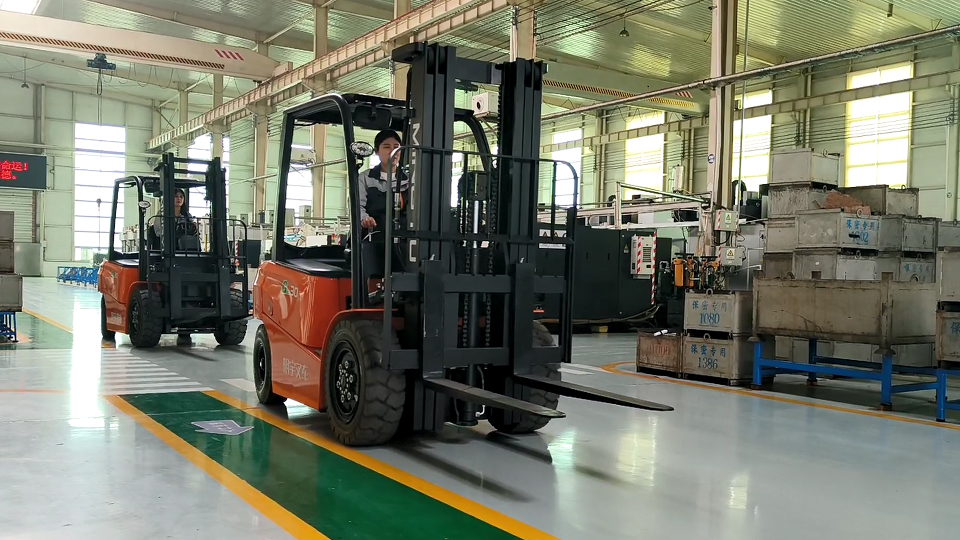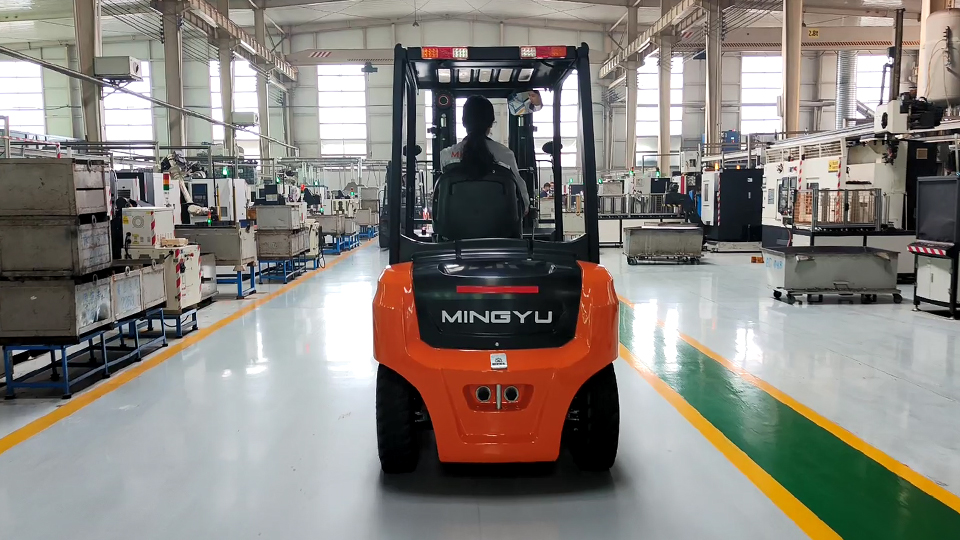
The Silent Revolution: Unpacking the Electric Forklift
The rhythmic hum and occasional piercing beep of a forklift are quintessential sounds in warehouses, construction sites, and manufacturing facilities worldwide. For decades, these powerful workhorses have relied primarily on internal combustion engines, fueled by propane, diesel, or gasoline. However, a quiet yet profound shift is underway. The question "Is there an electric forklift?" is not just valid; it reflects a burgeoning reality. The answer, unequivocally, is yes, and the implications of this electric revolution are far-reaching, impacting everything from operational efficiency and environmental sustainability to operator health and safety.
This article delves deep into the world of electric forklifts, exploring their evolution, the diverse range of models available, their inherent advantages and disadvantages compared to their internal combustion counterparts, the technological advancements driving their adoption, and the future landscape of material handling.
A Historical Glimpse: The Genesis of Electric Lift
While internal combustion forklifts gained prominence in the early to mid-20th century, the concept of electric-powered lifting equipment is not new. Early iterations of electric lift trucks emerged in the early 1900s, often used in specialized indoor applications where fumes and noise were significant concerns. These early models were often rudimentary, with limited lifting capacity and battery life. However, they laid the groundwork for the sophisticated electric forklifts we see today.
The latter half of the 20th century witnessed significant advancements in battery technology, motor efficiency, and control systems. This progress paved the way for electric forklifts to become increasingly viable alternatives to their internal combustion counterparts, even in more demanding applications. The rising awareness of environmental concerns and the pursuit of greater energy efficiency further accelerated the development and adoption of electric material handling equipment.
A Spectrum of Electric Power: Diverse Models for Diverse Needs
The term "electric forklift" encompasses a broad spectrum of machines, each designed to tackle specific material handling tasks. Understanding this diversity is crucial to appreciating the versatility of electric power in this domain. Key categories include:
Electric Counterbalance Forklifts: These are perhaps the most recognizable type of forklift. They utilize a counterbalance weight at the rear to offset the load being lifted at the front. Electric counterbalance forklifts come in various sizes and lifting capacities, ranging from small warehouse models capable of lifting a few thousand pounds to larger units handling several tons. They are highly maneuverable and suitable for a wide range of indoor and outdoor applications with relatively smooth surfaces.
Electric Reach Trucks: Designed primarily for indoor warehouse operations with narrow aisles, reach trucks feature outriggers and a mast that can extend forward, allowing them to "reach" into racking systems. Electric power is particularly advantageous here due to the need for precise control and quiet operation in confined spaces. Different variations exist, including stand-up and sit-down models, as well as deep-reach trucks for very high racking.
Electric Pallet Jacks and Stackers: These are lower-lift material handling equipment primarily used for moving pallets horizontally (pallet jacks) or stacking them at lower heights (stackers). Electric versions offer significant advantages over manual models in terms of operator fatigue and efficiency, especially in high-throughput environments.
Electric Order Pickers: Specifically designed for retrieving individual items from warehouse shelves, order pickers allow operators to be lifted to various heights for efficient picking. Electric power ensures smooth and controlled vertical movement, contributing to safety and productivity.
Electric Tow Tractors: Used for pulling trailers or carts within a facility, electric tow tractors offer a clean and quiet alternative to combustion engine versions, particularly in indoor manufacturing or distribution centers.
The availability of such a diverse range of electric forklift models underscores their adaptability and suitability for a vast array of material handling needs, challenging the traditional dominance of internal combustion engines across various industries.
The Electric Edge: Advantages Over Internal Combustion
The growing popularity of electric forklifts is driven by a compelling set of advantages they offer over their internal combustion counterparts:
Environmental Friendliness: This is perhaps the most significant driver. Electric forklifts produce zero tailpipe emissions, contributing to cleaner air quality, especially in indoor environments. This eliminates the health risks associated with exhaust fumes and aligns with increasing environmental regulations and sustainability initiatives.

Lower Operating Costs: While the initial purchase price of an electric forklift might be comparable or slightly higher than an internal combustion model, the long-term operating costs are typically significantly lower. Electricity is generally cheaper than propane, diesel, or gasoline. Furthermore, electric forklifts have fewer moving parts, leading to reduced maintenance requirements and lower downtime. There are no oil changes, filter replacements, or complex engine repairs to contend with.
Quieter Operation: Electric motors operate much more quietly than internal combustion engines. This creates a more comfortable and safer working environment, reducing noise pollution and improving communication among workers.
Improved Operator Comfort and Health: The absence of exhaust fumes and reduced noise levels contribute to a healthier and more comfortable working environment for forklift operators. Additionally, electric forklifts often have smoother acceleration and deceleration, reducing vibrations and operator fatigue.
Enhanced Maneuverability: Electric forklifts, particularly counterbalance models, often have a more compact design and a tighter turning radius compared to similarly sized internal combustion forklifts. This enhances maneuverability in confined spaces, improving efficiency and reducing the risk of accidents.
Precise Control: Electric motors offer precise control over speed and lifting operations, allowing for smoother and more accurate load handling. This is particularly beneficial in delicate or high-stacking applications.
Regenerative Braking: Many modern electric forklifts feature regenerative braking systems. When the operator decelerates or lowers a load, the kinetic energy is captured and used to recharge the battery, further improving energy efficiency and reducing brake wear.
Navigating the Terrain: Disadvantages and Considerations
Despite their numerous advantages, electric forklifts also have certain limitations and considerations that businesses must carefully evaluate:
Higher Initial Investment: As mentioned earlier, the upfront cost of an electric forklift, including the battery and charging infrastructure, can sometimes be higher than that of a comparable internal combustion model. However, this initial investment is often offset by lower operating costs over the lifespan of the equipment.
Limited Run Time and Charging Requirements: The operating time of an electric forklift is limited by the battery charge. Depending on the application intensity and battery capacity, a forklift may require recharging after a certain number of hours. This necessitates having spare batteries or implementing efficient charging schedules to minimize downtime.
Charging Infrastructure: Implementing an electric forklift fleet requires investing in charging infrastructure, including charging stations and potentially upgrading the electrical system. The type and number of chargers will depend on the size of the fleet and the charging requirements of the batteries.
Battery Maintenance and Replacement: While electric forklifts have lower overall maintenance, batteries require specific maintenance procedures, such as ensuring proper electrolyte levels (for lead-acid batteries) and avoiding deep discharge. Batteries also have a limited lifespan and will eventually need to be replaced, which can be a significant expense. However, advancements in battery technology, such as lithium-ion, are addressing some of these concerns with longer lifespans and reduced maintenance.

Performance in Extreme Conditions: While electric forklifts are increasingly capable in outdoor environments, extreme temperatures (both hot and cold) can affect battery performance and efficiency. Internal combustion forklifts may still be preferred in very demanding outdoor applications with prolonged exposure to harsh weather.
The Technological Spark: Innovations Driving Electric Forklift Advancement
The electric forklift landscape is constantly evolving, driven by significant advancements in several key areas:
Battery Technology: Lithium-ion batteries are rapidly gaining traction as a superior alternative to traditional lead-acid batteries. They offer several advantages, including longer cycle life, faster charging times, higher energy density, reduced maintenance, and consistent performance throughout the discharge cycle. While currently more expensive, the total cost of ownership of lithium-ion powered forklifts is becoming increasingly competitive.
Motor Efficiency: Advancements in electric motor design, such as AC (alternating current) motors, have led to increased efficiency, improved torque, and reduced energy consumption. These motors are also generally more robust and require less maintenance than their DC (direct current) counterparts.
Control Systems: Sophisticated electronic control systems optimize energy usage, improve responsiveness, and enhance safety features. These systems can incorporate regenerative braking, intelligent power management, and advanced diagnostics.
Charging Solutions: Innovations in charging technology are addressing the downtime concerns associated with electric forklifts. Fast charging systems can significantly reduce charging times, while opportunity charging allows for shorter charging bursts during breaks, maximizing uptime. Wireless charging technology is also being explored as a future possibility.
Telematics and Data Analytics: Integrating telematics systems into electric forklifts provides valuable data on battery usage, energy consumption, operating hours, and maintenance needs. This data can be analyzed to optimize fleet management, improve efficiency, and predict maintenance requirements.
The Future is Electric: A Paradigm Shift in Material Handling
The trajectory is clear: electric forklifts are not just a niche alternative; they are becoming the dominant force in material handling. Several factors are contributing to this paradigm shift:
Increasing Environmental Regulations: Governments worldwide are implementing stricter emission standards, making electric options increasingly attractive and sometimes mandatory, especially in indoor environments.
Growing Focus on Sustainability: Businesses are increasingly prioritizing sustainability initiatives and seeking ways to reduce their carbon footprint. Electric forklifts align perfectly with these goals.
Advancements in Technology: The continuous innovation in battery technology, motor efficiency, and charging infrastructure is addressing the traditional limitations of electric forklifts, making them viable for a wider range of applications.
Economic Benefits: The long-term cost savings associated with lower operating and maintenance expenses are becoming increasingly compelling for businesses.
Improved Workplace Environment: The benefits of quieter operation and zero emissions are contributing to healthier and more productive work environments.
While internal combustion forklifts will likely continue to play a role in certain niche applications, particularly those requiring very high lifting capacities or prolonged operation in extreme outdoor conditions, the electric revolution in material handling is well underway. The question is no longer "Is there an electric forklift?" but rather "How can we best integrate electric forklifts into our operations to maximize efficiency, sustainability, and cost-effectiveness?"
In conclusion, the electric forklift is not a futuristic concept; it is a present-day reality with a rich history and a promising future. Driven by technological innovation and a growing global emphasis on sustainability, these silent workhorses are transforming the material handling industry, one emission-free lift at a time. As battery technology continues to advance and charging infrastructure becomes more widespread, the electric forklift is poised to become the undisputed champion of material movement in the years to come.
Name: selena
Mobile:+86-13176910558
Tel:+86-0535-2090977
Whatsapp:8613181602336
Email:vip@mingyuforklift.com
Add:Xiaqiu Town, Laizhou, Yantai City, Shandong Province, China